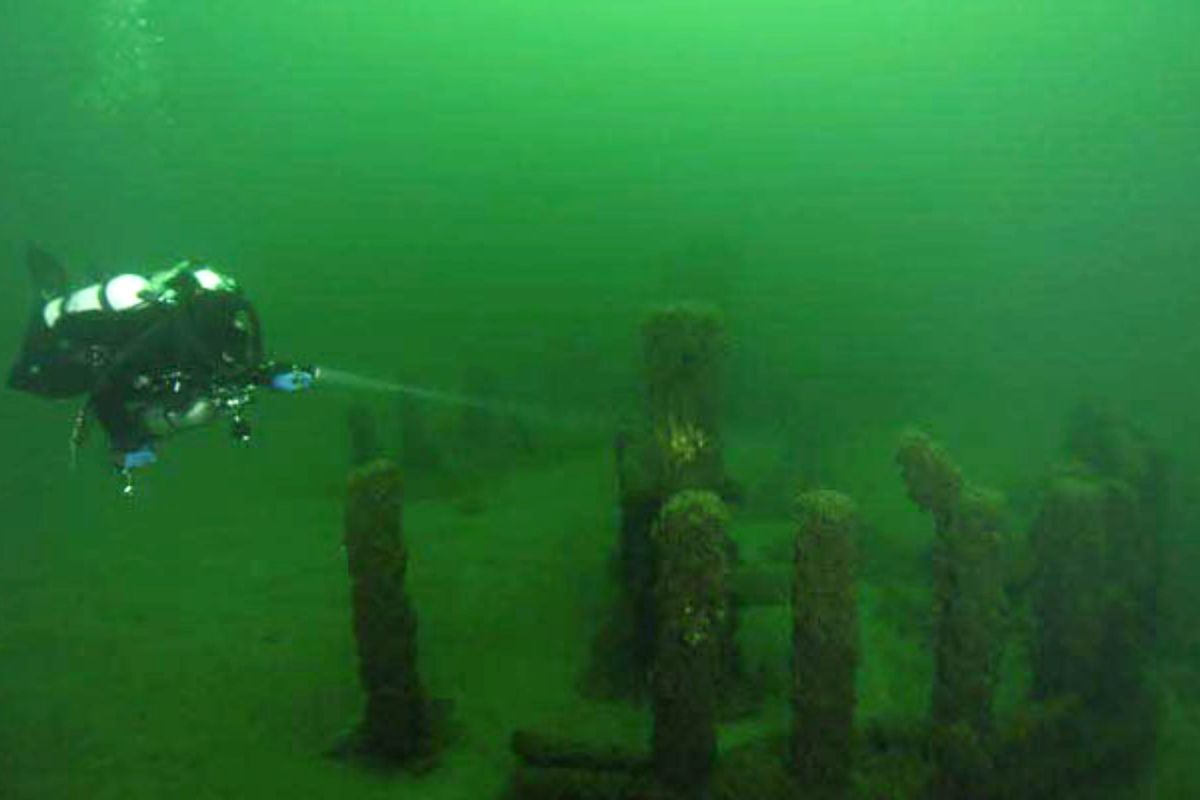Strange 'Stonehenge' discovered in US lake that's 5,000 years older than the British landmark
.
The true reasons behind this ancient structure's construction remain a great enigma, with leading scholars and archaeologists worldwide unable to agree on the purpose of its creation.
in the US.
Not only that, but this underwater discovery is approximately five thousand years older than its British equivalent.
The site was uncovered in 2007 by an archaeological team led by Mark Holley, a professor of underwater archaeology at Northwestern Michigan College.
Holley and his colleagues were undertaking a survey of the lake bed when they stumbled upon a collection of large stones, arranged in a circular formation, situated just offshore of Traverse City, in the state of Michigan.

Holley afterwards confessed that the discovery, made at approximately 40 feet below, came as a complete surprise, and that he and his team were initially uncertain about what they had found.
reports.
This design is approximately 40 feet across and includes a second ring, shaped like a circle, which is roughly 20 feet across in size.
These granite stones, sourced from the local area, are thought to be approximately 10,000 years old, making the formation one of the oldest found in North America thus far.
Indeed, despite the Lake Michigan stones resembling those of Stonehenge in size and shape, their provenance remains quite unclear.
.
“While we know that prehistoric tribes inhabited the Great Lakes region for thousands of years, our understanding of them is sadly limited,” he noted, pointing out that he hasn’t come across anything similar to this discovery in his study of the archaeological record.”
Nelson spoke to Hank, a man whose ancestors were part of the Anishinaabe community, who were among the first inhabitants of the area.
Hank believes that his tribe's ancient, prehistoric forebears - who inhabited the area after the last Ice Age - positioned the stones for a ceremonial reason.
In the Anishabe culture, the people see stones as living objects because they are born from the Earth, who is considered alive," he explained, pointing out that the monument's presence in the lake demonstrates that his people have been there for a long time.
Holly," the expert observed, "indicated that the region was not beneath the water approximately 10,000 years ago, and that settlers had indeed established their communities on the precise location where the stones were later positioned.
“Wouldn't it have been a lovely spot for people to inhabit, not far from the coast, with easy access to essentials and regular transport links," the archaeologist said to Nelson.
However, he went on, some 5,000 years after that, the water levels surged, flooding the basin of Lake Michigan.
Thanks to advanced technology referred to as stereo photogrammetry, Nelson was able to assemble photographs of the rocks into a realistic three-dimensional image, which he was then able to inspect in detail.
Fascinating details have been uncovered on some of the stones, including an image that strongly resembles a Mastodon.

Mastodons are extinct relatives of elephants and woolly mammoths, which were once among the largest land animals to have walked across North America.
They reached heights of up to 10 feet (3.1m) and weighed in excess of over six tonnes. These enormous creatures roamed during the Pleistocene era, which spanned from approximately 2.6 million to 11,700 years ago.
The carvings imply that the individuals who constructed the site were familiar with these creatures, and possibly even partook in hunting them.
Dr. John O'Shea, Curator of Great Lakes Archaeology at the University of Michigan, pointed out that the reference to Mastodons alongside the unusual formation, featuring a straight line of rocks leading directly towards it, may indicate that it served as an ancient hunting structure, specifically a drive lane.
Dr O'Shea explained to Nelson that humans have employed a tactics of creating guided channels for countless millennia to direct large congregations of animals onto a specific area where the hunters would be positioned, ready to catch them.
If that is the case, the website disputes the widely-held assumption that our early ancestors lacked the capacity to create such advanced constructions.
Despite its design, the true reason behind the structure's building and the identity of its creators remain unclear – somewhat similar to its counterpart in Salisbury, which is significantly younger.
For our free world news digest sent directly to you
Please share your thoughts about this article on our news forum. Add your comments below.
Post a Comment for "Strange 'Stonehenge' discovered in US lake that's 5,000 years older than the British landmark"